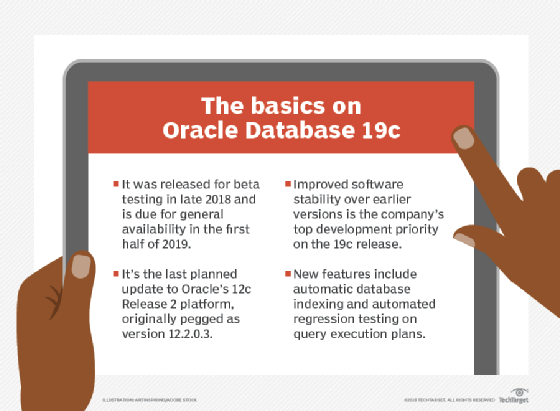
Dmitriy Shpilko - Fotolia
Key new features coming in Oracle Database 19c
With Oracle Database 19c, Oracle is aiming to boost the stability of its flagship software's latest generation. But 19c also offers DBAs a variety of added features.
Oracle Database 19c is slated for release in the first half of 2019, bringing with it a number of new and improved features. The full extent of what will be included isn't clear yet: Most of the available information about 19c comes from sessions at Oracle OpenWorld 2018 in October, with few new details emerging since then.
Also, the primary focus of Oracle 19c is more on improving software stability than adding a bumper crop of features, according to Oracle. The new version is due to be the last in the Oracle Database 12c Release 2 product family, renamed to hew to the annual update schedule that the company adopted starting with the delivery of Oracle Database 18c earlier this year.
Nonetheless, here's an overview of what's expected to be in the 19c release, with the proviso that things can change before the technology -- now in beta testing -- becomes generally available.
Automated testing of query plans
With Oracle Database 19c, database administrators (DBAs) will no longer need to manually perform regression tests on new query execution plans prior to upgrading from earlier versions of the database management system. New functionality built into 19c will automatically check the built-in execution plans against existing ones, and then replace the current plans that can benefit from being upgraded and retain those that will be faster without the upgrade.
The promise here is that queries will run as well as or better than before -- without DBAs having to take any action.

Workload isolation in the cloud
After Oracle 19c has been incorporated into the Oracle Autonomous Database cloud service, DBAs will be able to deploy applications on dedicated Exadata systems in the Oracle Cloud platform. In this way, organizations can implement their workloads in isolated computing environments rather than having to share a multi-tenant pool of cloud-based machines.
Database teams will also be able to install systems running the Autonomous Transaction Processing and Autonomous Data Warehouse versions of the cloud service in their own data centers as part of Oracle's Cloud at Customer program.
Automatic indexing
One of the most talked about features coming in Oracle Database 19c is automatic indexing, which Oracle says is based on common SQL tuning methods. The difference is that the process will be fully automated instead of being manual. Oracle Database 19c will identify candidate indexes, verify their effectiveness, perform online validations and then implement the indexes where appropriate.
Additionally, all tuning activities will be auditable with the database system's reporting capabilities.
Data Guard DML redirection
Oracle Data Guard is add-on software that's designed to help DBAs install, manage and monitor standby databases for high availability and disaster recovery purposes. With the release of Oracle Database 19c, Data Guard will get added support for data manipulation language (DML) redirection.
This new feature will make it possible to run DML statements against an active standby database. Data Guard will redirect the statements to the primary database, where the data changes will be applied. The updated data will then be streamed back to the standby database to maintain redundancy.
Easy Connect enhancements
Oracle Database 19c will also include several improvements to Oracle's Easy Connect naming methodology. Also known as EZConnect, this approach streamlines the process of connecting to Oracle databases over TCP/IP networks, letting users do so without having to perform lookups in the tnsnames.ora files.
The Easy Connect syntax will be simplified in Oracle 19c. In addition, Oracle plans to add support for including multiple hosts and ports in connection strings, which is designed to make it easier to load-balance client connections. The Easy Connect adapter will also accept a list of name-value pairs, such as CONNECT_TIMEOUT=60&RETRY_COUNT=3.
Fast ingestion of IoT data
Like many technologies, Oracle Database is being updated to better accommodate the influx of IoT data. To this end, Oracle is adding memory-optimized access for IoT workloads to the 19c release in order to boost the performance of streaming data inserts from IoT devices. Clients will write directly to in-memory buffers, where the writes will be deferred and then processed in large batches, leading to faster insert throughput -- if all goes according to Oracle's plan.
Other features to look for
Oracle Database 19c is also slated to incorporate various other enhancements. These additions include partitioned hybrid tables, statistics-only queries, encryption capabilities in the built-in data dictionary, support for partial updates of JSON data columns, expanded sharding capabilities for pluggable databases in the Oracle Multitenant architecture, and the ability to use Oracle's Real Application Testing and Automatic Database Diagnostic Monitor tools with pluggable databases.
In addition to the new and updated features, Oracle Database 19c has been designated as a long-term support release, meaning it will be covered under Oracle's Premier Support program until at least March 2023, with extended support potentially continuing into 2026.
Despite what Oracle has said thus far, nothing will be completely certain until Oracle Database 19c is released or first deployed as part of the Autonomous Database service in the cloud. Until then, we'll have to wait for more details to trickle out from Oracle or for more early users to report what they find. The beta program is underway if you want to get your hands on the Oracle 19c software and give it a try.






